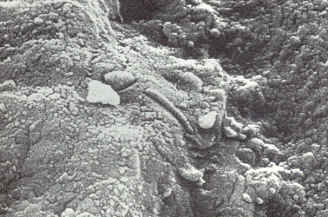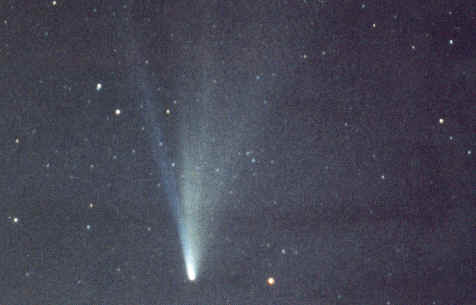

As rare as life on Earth seems to
be, it may not have started here at all. Planets
may frequently be seeded by life from other nearby planets, and this may have
happened to Earth. It’s possible
that life arose on Mars or Venus and then transferred to Earth.
“If microorganisms, the primitive but nearly indestructible creatures,
exist on a given world, they must inevitably travel to its immediate
neighbors. There is a natural
‘interplanetary transport system’ that distributes rocks between nearby
planets.” (Ward & Brownlee 71) These
rocks serve as natural transporters capable of carrying these indestructible
creatures from the surface of one planet, across hundreds of millions of miles
of space to neighboring planets. “It
is an unavoidable act of nature.”(71)
“Each year, half a dozen 1-pound or larger rocks impact
Earth from Mars.” (71) These rocks are ejected off Mars by large impacts and
some find their way to orbits crossing that of Earth, where they occasionally
collide after only a few months in transit.
There had been little expectation that rocks capable of
carrying living microbes from planet to planet would survive the great violence
of a launch out of the atmosphere. It
was formerly believed that the launch process would shock-melt or at least
severely heat ejected material, which would sterilize any potential life in the
rocks. The discovery of
extraterrestrial rocks in Antarctica has shown that it is possible for these
rocks to survive the launch process. “Over
Earth’s lifetime, billions of football-size Martian rocks have landed on its
surface… Like plants releasing seeds into the wind, or palms dropping coconuts
into the ocean, planets with life could seed their neighbors.” (71-21)
If microbes are shielded well on a rock, they can survive long enough to possibly “seed” other planets in a solar system, or even other areas of a galaxy. It may be possible that Earth’s seed came from another solar system in the Milky Way.


Once
any planet in a particular solar system is “infected” with life from another
planet, this planet may spread life to yet another planet and through other
systems. This process can only work
on organisms that can withstand extreme conditions.
Animal life cannot survive the raw vacuum of outer space, and thus cannot
spread in this fashion.
-K. Marks
Biological Evolution
and the Importance of Oceans
“Surely, the mitochondrion that first entered another cell
was not thinking about the future benefits of cooperation
and integration; it was merely trying to make its own living
in a tough Darwinian world.” –Stephen Jay Gould
As we’ve established in today’s society, water is a vital resource to avoid fatality. It is required to nourish the life forms that inhabit our planet. Provided to our species through oceans, water has become an essential element to life, as it has housed the first particles to settle on our planet, and the first molecules, which evolved into the beings we are today.
Approximately 3.8 billion years ago, when our planet was first being created, it was believed that meteors violently crashed onto the newly formed Earth, bringing various evolving atoms with them. When given the correct elements, these atoms would soon create cells, which would become the first form of life on Earth.
At the same time the atoms were settling on Earth, steam from the hot conditions of impacts was condensing and settling. The pools of settled condensation soon grew into oceans. The oceans then proved their importance by housing some of the molecules. These molecules were able to use the light and energy produced by the sun and turn it into food, a process called photosynthesis. As a result, about three and a half billion years ago, they began to produce oxygen as a byproduct, which oxygenated the oceans.
Because our atmosphere acts like an umbrella, providing a net to contain the oxygen the simple ocean life produced, our planet became surrounded by a significant amount of oxygen. Eventually, the simple life forms evolved into green plants within the underwater world. Throughout time, the single celled organisms began evolving into more complex life forms, eventually leaving their aquatic habitats for new ones on land.
Unlike many planets, Earth has a more hospitable environment for life, as opposed to the surface-less jovian planets, or the hostile atmospheres of Jupiter or Neptune. Temperature, ocean currents, fluctuating seasonal rainfall, and distribution of nutrients all contributed to the biodiversity that we have now come to know. It is believed that continental drift played a further part in the creation of different species, by assisting in the adaptations of species to the varying climates of our planet. Evolution was in full swing.
-S. Mangus